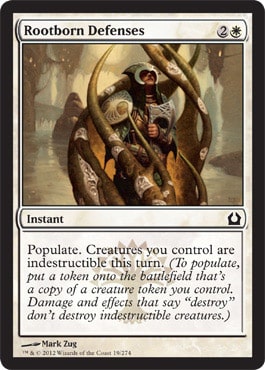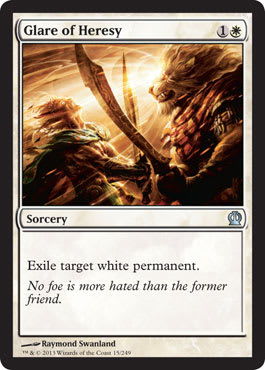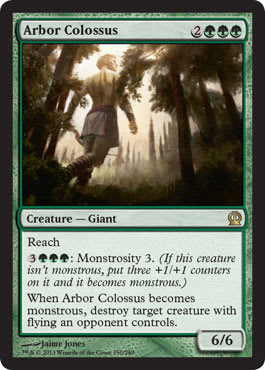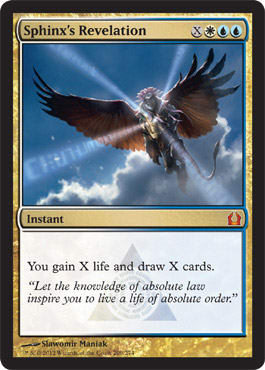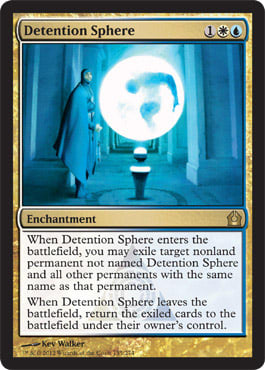Huh, I guess it really has been awhile since I was last here. I’m back now, and today, I want to go over two base decks for post-Theros Standard. The first is looking at the Selesnya shell for aggro and midrange, both of which have had some success to date in Block and Standard. If creature beats aren’t your cup of tea, just look for Sphinx's Revelation in the second part of the article.
Selesnya
Selesnya is among the most powerful shells I’ve seen so far, and a big part of that comes from how efficient the creatures are. It’s a hard sell to play straightforward aggro with little room to maneuver, but when you have the best creatures at every slot, that’s sometimes good enough. What it also means is that if you’re willing to pay the extra mana for trickier spells and creatures (Boon Satyr and Trostani, Selesnya's Voice come to mind), you still have that same creature edge in the early game and more play down the road.
Let’s take a look at both approaches and the pros and cons of each.
"Selesnya Aggro"
- Creatures (25)
- 1 Boon Satyr
- 4 Experiment One
- 4 Fleecemane Lion
- 4 Loxodon Smiter
- 4 Scavenging Ooze
- 4 Soldier of the Pantheon
- 4 Voice of Resurgence
- Planeswalkers (2)
- 2 Ajani, Caller of the Pride
- Spells (10)
- 1 Gods Willing
- 1 Rootborn Defenses
- 4 Advent of the Wurm
- 4 Selesnya Charm
- Lands (23)
- 8 Plains
- 9 Forest
- 2 Selesnya Guildgate
- 4 Temple Garden
- Sideboard (15)
- 3 Boon Satyr
- 4 Glare of Heresy
- 2 Pacifism
- 2 Arbor Colossus
- 2 Elspeth, Sun's Champion
- 1 Rootborn Defenses
- 1 Mutavault
Pros
This has the best creatures up to 4 mana and arguably the best Charm as well.
While you don’t have very many tricks, the ones you do have are really impressive. Rootborn Defenses shuts down Supreme Verdict and Anger of the Gods while potentially netting you another creature. Boon Satyr can negate a burn spell or win a late-game creature fight. Boon Satyr in general just provides you with another flash creature to go alongside Advent of the Wurm and ambush people with or keep planeswalkers in check.
You force Supreme Verdict from the Island decks because they can’t trade one-for-one and expect to come out ahead. Experiment One can potentially wreck their plans for playing Supreme Verdict into Jace, Architect of Thought, and that’s just your 1-drop! Scavenging Ooze and Fleecemane Lion both get out of hand quickly when played post-sweeper, and Advent of the Wurm isn’t much worse. Voice of Resurgence only looks better when you can slam an Elspeth, Sun's Champion after it dies post-board.
Cons
You see those Glare of Heresy in the board? Welcome to a 2-mana removal spell that kills nearly all of your best threats and dodges indestructible and Voice’s trigger. This is going to be a real rough spell to deal with if the opponent decides he’s tired of losing to your gold creatures.
Once again, you have very little play with this deck, so you’ll be relying entirely on sequencing correctly and playing the occasional bluff. Much like the red decks, the creature base is strong enough that this should work if you maximize your damage and don’t throw away cards. Remember that you don’t have access to planeswalkers to make up card advantage, at least for Game 1, and that you have no card manipulation. Threat evaluation is huge with Selesnya Charm, and the Limited rule of saving your one removal spell applies here.
Notes
Boon Satyr may end up as a main-deck card and could potentially be a better 3-drop than Loxodon Smiter. It’s hard to believe, I know, but I’m quite surprised at the amount of versatility you gain from Boon Satyr. Bestow really makes a huge difference in how playable Wolfir Avenger is.
"Selesnya Midrange"
- Creatures (25)
- 2 Archangel of Thune
- 2 Boon Satyr
- 3 Fleecemane Lion
- 4 Elvish Mystic
- 4 Loxodon Smiter
- 4 Scavenging Ooze
- 4 Voice of Resurgence
- 2 Trostani, Selesnya's Voice
- Planeswalkers (2)
- 2 Elspeth, Sun's Champion
- Spells (8)
- 4 Advent of the Wurm
- 4 Selesnya Charm
- Lands (25)
- 10 Forest
- 7 Plains
- 4 Selesnya Guildgate
- 4 Temple Garden
- Sideboard (15)
- 1 Elspeth, Sun's Champion
- 2 Boon Satyr
- 4 Witchstalker
- 3 Fade into Antiquity
- 2 Arbor Colossus
- 3 Glare of Heresy
Pros
This demolishes opposing aggro strategies and can be configured against any potential aggro or midrange plan in the format. Besides the aforementioned creature efficiency, you retain several minor combos that crush aggression: Trostani, Selesnya's Voice with Advent of the Wurm, Archangel of Thune with Scavenging Ooze, and Witchstalker with Boon Satyr.
While your creatures are hit by a lot of removal W/U and Esper will be packing, the majority of your creatures end the game on their own. After sideboarding, you have access to more planeswalkers, Heliod, God of the Sun—who can act like Mobilization—and the aforementioned Witchstalker; plus, Boon Satyr can allow for more resilience. Just slowly doling out threats and taking advantage of bestow can help immensely when trying to minimize the impact of Supreme Verdict.
This list probably has the best mana of any two-colored deck in the format since you can max out on Gates with no ill consequence. If worried about red decks casting Shock on Elvish Mystic, it only requires a simple switch to Sylvan Caryatid.
Boon Satyr joins Advent of the Wurm to gives you a few more plays at instant speed. This is very relevant; before, the only reason you would ever hold open mana against Island decks is because you had Advent or Rootborn Defenses.
Cons
You can’t really play around Supreme Verdict outside of two easy-to-read ways. Either you play one or two threats at a time and bleed the opponent’s removal or you jam out everything on curve and ask if he or she has Supreme Verdict. Supreme Verdict is still good against both plans, you just are able to distort the value slightly less in the opponent’s favor by playing slower. Esper can run the same game on you with Far // Away, and it just feels miserable. At least Anger of the Gods can’t kill the entire deck like other creature-based plans.
Arbor Colossus is a concession to the fact that Stormbreath Dragon is a real Magic card and will eat a lot of people’s faces when all is said and done. While you have some life-gain, your opponent can often just jam one of these and live long enough for it to deal 15. I know some people consider monstrosity to be some imaginary ability that just fills space, but having played against, it I can safely say you need an answer to a 7/7 flyer you can’t Selesnya Charm.
Some of your draws are pure clunkiness that can’t be worked out. Part of the reason Jund was good for so long is that Farseek smoothed out a lot of draws and the cards were powerful enough to make up for a turn of do nothing. This deck is not and simply can’t afford to miss early drops, even if it isn’t trying to be aggressive. Of course, in the end, you’ll still be the most aggressive midrange deck on the block simply because there are certain cards that are very hard to answer.
Cards such as Blood Baron of Vizkopa and Obzedat, Ghost Council may not be game over for this deck, but both put it in a very awkward position. You must attack to deal with planeswalkers, and that’s another blow against a deck with little removal and no real evasion. The list goes on of cards that don’t outright stomp you and instead just slowly wear you down and force you into miserable positions.
Both decks are going to be reasonably powerful and playable barring a huge metagame shift, and people will be out looking for optimized builds. What’s nice is that while the deck has a lot of inherent power spread across its cards, it doesn’t create a position of everything being a bit too good. In last Standard, there was a definite feeling that answers couldn’t beat threats simply because the threats were all too powerful or resilient for the mana cost. While Selesnya threats are among the best, the most resilient and scary ones cost more mana.
W/U Control
The other deck that I’ve put a fair amount of work into is straight UW control. I’m unsure if this control shell is outright better than Esper or Grixis, but the mana is so much better that I can’t really bring myself to recommend either one over straight W/U. If and when someone comes up with a respectable mana base that doesn’t involve trying to jam a Keyrune or Chromatic Lantern, I’ll switch over—having more options is where you want to be. Until that point, though, I’m going to stick with what I have.
"W/U Control"
- Creatures (1)
- 1 Aetherling
- Planeswalkers (6)
- 2 Elspeth, Sun's Champion
- 4 Jace, Architect of Thought
- Spells (26)
- 1 Last Breath
- 2 Celestial Flare
- 2 Dissolve
- 3 Essence Scatter
- 4 Azorius Charm
- 4 Sphinx's Revelation
- 1 Divination
- 4 Supreme Verdict
- 4 Detention Sphere
- 1 Ratchet Bomb
- Lands (27)
- 10 Island
- 7 Plains
- 2 Encroaching Wastes
- 4 Azorius Guildgate
- 4 Hallowed Fountain
- Sideboard (15)
- 3 Jace, Memory Adept
- 1 Gainsay
- 2 Dispel
- 2 Negate
- 1 Ratchet Bomb
- 3 Archangel of Thune
- 2 Blind Obedience
- 1 Pithing Needle
Here’s a breakdown of what I feel is the core and the rest of the deck.
- 4 Azorius Charm
- 4 Detention Sphere
- 4 Supreme Verdict
- 3 Sphinx's Revelation
- 3 Essence Scatter
- 2 Dissolve
- 1 Aetherling
- 3 Jace, Architect of Thought
- 1 Elspeth, Sun's Champion
- 1 Aetherling
You absolutely need twelve or more dedicated removal spells, and there’s no corner-cutting since Azorius Charm isn’t a real solution. In essence, you have eight actual removal pieces and whatever extra ones you decide to run. The upside about this is that Supreme Verdict will now do what the text box says instead of merely implying it would accomplish a board wipe. Yes, the last year of Standard has really disrespected sweepers, and now it’s time to go back to our roots, where casting a Verdict kills ninety-nine percent of threats. You also no longer are punished for blowing up the board and tapping out for a Jace or Elspeth, whereas before, you’d probably take a Thundermaw Hellkite or Hellrider to the dome.
Detention Sphere receives a major upgrade because you’ll rarely be punished for tapping out on turn three, and it deals with planeswalkers. Since the threats received a downgrade across the board and the legend rule was changed, planeswalkers now factor in more heavily for control decks. Sitting there against a Domri Rade or Chandra, Pyromaster is not where you want to be for very long, and having immediate answers is going to be a must. Pithing Needle may also be a consideration just to assist with keeping planeswalkers in check as well as handling slightly odd threats such as Maze's End.
Essence Scatter and Dissolve comprise my current counter suite, and while you don’t need to copy this exact set, I do believe five to six counterspells should be in every W/U deck. Cavern of Souls and massive noncreature threats are in short supply, meaning Essence Scatter becomes far more relevant. You also won’t be being pressured quite as much by nonred decks, so holding open ![]()
![]() over casting a spell isn’t quite as painful as it once was. Scatter also becomes more attractive when you can mix it up with other countermagic and Celestial Flare (or any other 2-mana spell) that was too cute for straight W/U Flash.
over casting a spell isn’t quite as painful as it once was. Scatter also becomes more attractive when you can mix it up with other countermagic and Celestial Flare (or any other 2-mana spell) that was too cute for straight W/U Flash.
Sphinx's Revelation is going to be a three-of in every W/U/x deck, and a few radicals will run four. I understand if you don’t want to run four because drawing two early is kind of miserable. I want four simply because drawing a million cards and chaining Revelation’s is all I want to do. Maybe it’s a crutch, but I win almost every game in which I’m able to chain Revelation, and I’ve lost plenty in which I cast one and couldn’t find another to lock up the game—instead running out of gas. So, while I understand why most players only want three, I’m going to run four until the card rotates out or I have a good reason. (Perhaps I’m playing four Steam Augury and don’t want every hand to feature a bunch of useless card-draw.)
As for the planeswalker base, Elspeth, Sun's Champion has tested really well so far and provides a useful end-game threat that has immediate board impact. It also provides a few more answers to creatures such as Stormbreath Dragon, which conveniently has a text insert that says, “Laugh at W/U’s removal.” Jace, Architect of Thought is going to see plenty of play, and we all saw that coming, as he slowly crept back into W/U lists toward the end of this season and was a four-of in Block. This may be the perfect environment for him to thrive, with his +1 shutting down normal aggro and having time to leverage the -2 against other control plans.
Where my list differs from a number of players is that I include the fourth copy of many cards that people don’t necessarily want to see multiples of. I already explained my logic for Revelation, and the same follows for Jace—being able to chain Jaces or force the opponent to spend multiple turns killing one only to play another is a big game. Celestial Flare is another preference toward redundancy, having more removal that deals with indestructible and hexproof threats that half my removal doesn’t touch.
One nice thing about this type of strategy is that, while the format looks to be flush with removal, you are able to duck the majority of it by running no creatures outside of Aetherling.
One card I’m going back and forth on is Omenspeaker, which was previously a three-of in this deck, and the current version is simply playing more removal and a single Divination instead. I really like Omenspeaker against red decks because it blocks all of those decks’ creatures and helps dig for Supreme Verdict (plus Archangel of Thune post-board). Unfortunately, the more I tried it against other decks, the less success I had with it. It’s atrocious in the control mirrors, and there aren’t a lot of aggressive midrange decks like Kibler’s Gruul or Junk Aristocrats. Players going midrange are thoroughly in the 3- to 5-mana slot on the curve and play creatures that ignore a 1/3.
Another creature that I’ve considered for the sideboard and may see sideboard play is Soldier of the Pantheon, which reminds me fondly of Kor Firewalker. It isn’t quite as backbreaking, especially in multiples, as Firewalker was, but it still puts a major hurting on decks that are heavy on gold cards. Against decks like Selesnya, up to half the creatures are gold and can’t possibly make it past my Soldier, and it’s still a 1-drop that trades off against red and white aggressive decks. Oh, and you gain some life if it lives for any amount of time because the opponent isn’t going to stop casting creatures if Soldier is on the field. Soldier of the Pantheon forces players to play into Supreme Verdict without a Rancor or Kessig Wolf Run to give their creatures trample.
While I can’t give real matchups this early into the format, I can say from my early testing that mono-red and the aggressive creature decks aren’t going to have fun against this deck. While Selesnya creatures can work as standalone threats, red and other colors don’t have this advantage and instead are trashed by Supreme Verdict. Jace becomes much better when players can’t casually slam Falkenrath Aristocrat, Hellrider, or Thundermaw Hellkite onto the table and you can run varied enough removal to deal with the better threats.
That’s all from me for this week. While I won’t be a weekly contributor to GatheringMagic, I hope to be producing more content soon. Thanks for reading, and good luck at your release events.
Josh Silvestri
Email me at josh.silvestri at gmail dot com
















